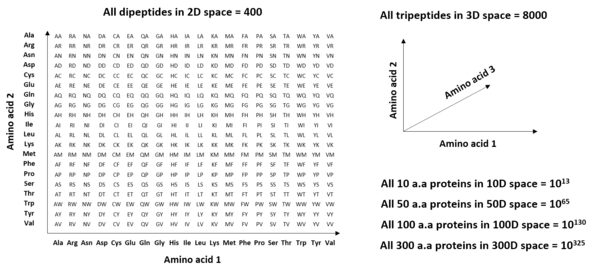Sequence space (evolution)

In evolutionary biology, sequence space is a way of representing all possible sequences (for a protein, gene or genome).[1][2] The sequence space has one dimension per amino acid or nucleotide in the sequence leading to highly dimensional spaces.[3][4]
Most sequences in sequence space have no function, leaving relatively small regions that are populated by naturally occurring genes.[5] Each protein sequence is adjacent to all other sequences that can be reached through a single mutation. Evolution can be visualised as the process of sampling nearby sequences in sequence space and moving to any with improved fitness over the current one.
Representation
A sequence space is usually laid out as a grid. For protein sequence spaces, each residue in the protein is represented by a dimension with 20 possible positions along that axis corresponding to the possible amino acids.[3][4] Hence there are 400 possible dipeptides arranged in a 20x20 space but that expands to 10130 for even a small protein of 100 amino acids arranges in a space with 100 dimensions. Although such overwhelming multidimensionality cannot be visualised or represented diagrammatically, it provides a useful abstract model to think about the range of proteins and evolution from one sequence to another.
These highly multidimensional spaces can be compressed to 2 or 3 dimensions using principal component analysis. A fitness landscape is simply a sequence space with an extra vertical axis of fitness added for each sequence.[6]
Functional sequences in sequence space
Despite the diversity of protein superfamilies, sequence space is extremely sparsely populated by functional proteins. Most random protein sequences have no fold or function.[7] Enzyme superfamilies, therefore, exist as tiny clusters of active proteins in a vast empty space of non-functional sequence.[8][9]
The density of functional proteins in sequence space, and the proximity of different functions to one another is a key determinant in understanding evolvability.[10] The degree of interpenetration of two neutral networks of different activities in sequence space will determine how easy it is to evolve from one activity to another. The more overlap between different activities in sequence space, the more cryptic variation for promiscuous activity will be.[11]
Protein sequence space has been compared to the Library of Babel a theoretical library containing all possible books that are 410 pages long.[12][13] In the Library of Babel, finding any book that made sense was impossible due to the sheer number and lack of order. The same would be true of protein sequences if it were not for natural selection, which has selected out only protein sequences that make sense. Additionally, each protein sequences is surrounded by a set of neighbours (point mutants) that are likely have at least some function.
See also
References
- ↑ DePristo, Mark A.; Weinreich, Daniel M.; Hartl, Daniel L. (2 August 2005). "Missense meanderings in sequence space: a biophysical view of protein evolution". Nature Reviews Genetics. 6 (9): 678–687. doi:10.1038/nrg1672.
- ↑ Maynard Smith, John (7 February 1970). "Natural Selection and the Concept of a Protein Space" (PDF). Nature. 225 (5232): 563–564. doi:10.1038/225563a0. PMID 5411867.
- 1 2 Bornberg-Bauer, E.; Chan, H. S. (14 September 1999). "Modeling evolutionary landscapes: Mutational stability, topology, and superfunnels in sequence space". Proceedings of the National Academy of Sciences. 96 (19): 10689–10694. doi:10.1073/pnas.96.19.10689.
- 1 2 Cordes, MH; Davidson, AR; Sauer, RT (Feb 1996). "Sequence space, folding and protein design.". Current Opinion in Structural Biology. 6 (1): 3–10. doi:10.1016/S0959-440X(96)80088-1. PMID 8696970.
- ↑ Hermes, JD; Blacklow, SC; Knowles, JR (Jan 1990). "Searching sequence space by definably random mutagenesis: improving the catalytic potency of an enzyme.". Proceedings of the National Academy of Sciences of the United States of America. 87 (2): 696–700. doi:10.1073/pnas.87.2.696. PMC 53332
 . PMID 1967829.
. PMID 1967829. - ↑ Romero, PA; Arnold, FH (Dec 2009). "Exploring protein fitness landscapes by directed evolution.". Nature reviews. Molecular cell biology. 10 (12): 866–76. doi:10.1038/nrm2805. PMC 2997618
 . PMID 19935669.
. PMID 19935669. - ↑ Keefe, AD; Szostak, JW (Apr 5, 2001). "Functional proteins from a random-sequence library.". Nature. 410 (6829): 715–8. doi:10.1038/35070613. PMID 11287961.
- ↑ Stemmer, Willem P. C. (June 1995). "Searching Sequence Space". Bio/Technology. 13 (6): 549–553. doi:10.1038/nbt0695-549.
- ↑ Bornberg-Bauer, E (Nov 1997). "How are model protein structures distributed in sequence space?". Biophysical Journal. 73 (5): 2393–403. doi:10.1016/S0006-3495(97)78268-7. PMC 1181141
 . PMID 9370433.
. PMID 9370433. - ↑ Bornberg-Bauer, E; Huylmans, AK; Sikosek, T (Jun 2010). "How do new proteins arise?". Current Opinion in Structural Biology. 20 (3): 390–6. doi:10.1016/j.sbi.2010.02.005. PMID 20347587.
- ↑ Wagner, Andreas. The origins of evolutionary innovations : a theory of transformative change in living systems. Oxford [etc.]: Oxford University Press. ISBN 0199692599.
- ↑ Arnold, FH (2000). "The Library of Maynard-Smith: My Search for Meaning in the protein universe". Advances in protein chemistry. 55: ix–xi. PMID 11050930.
- ↑ Ostermeier, M (March 2007). "Beyond cataloging the Library of Babel.". Chemistry & Biology. 14 (3): 237–8. doi:10.1016/j.chembiol.2007.03.002. PMID 17379136.